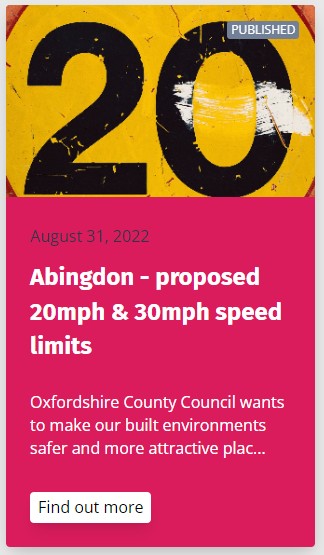
Abingdon Town Council has applied for 20 MPH limits in the residential areas of the town and a reduction of the ‘ring road’ to 30 MPH. Oxfordshire County Council is now consulting on the new limits between 31st August and 30th September at https://letstalk.oxfordshire.gov.uk/abingdon_2030mph2022.
Many other areas in the county, the country, and the world are going through the same process to reduce severe road casualties and encourage cyclists and pedestrians by making it feel safer.

The 30 MPH limit was introduced in urban areas in March 1935, as reported above in the Birmingham Gazette of 19th March 1935. Thanks to the British Newspaper Archive for the copy.
Not much has changed since 1935. People caught driving too fast were called ‘victims’ then and many (not all) still have the same mindset today, supported and encouraged by some elements of the media.
Some roads are already effectively subject to a 20mph limit; others ought to be. But who will police the new limits? Thames Valley Police don’t have the resources to apply the existing legislation. The proposals may make some sense on paper; but, if they are no (or cannot) be enforced, it will bring the law into further disrepute.
Do councillors know how much time it takes police officers to log offences both at the roadside and back at the station at the end of a shift?
I would be much more impressed, if the roads were properly maintained – repaired rather than patched and with signage made visible rather than obscured by trees and bushes. Making our roads safe requires far more than simply sticking up 20mph signs.
No need to adjust limits. The ring road only has homes and businesses on one side of it. There is very little need for people to cross it in most areas. Where there are amenities on the other side there are largely pedestrian crossings.
The whole point of the ring road is to keep traffic moving slowing it down is worse for congestion and the environment
I wonder who it is that comes up with these bandwagon jumping ideas? They are ever so ill thought-out.
National speed limit rural roads have to be maintained (paid for) by the Highway’s agency. Many of these roads are now having their speed limits reduced under the banner of “road safety” but there is strong argument that it comes down to money. As the Highways agency is not responsible for their upkeep if the speed is lower, local authorities are. (Or so someone told me down the pub)….
Would I be surprised if there is a similar financial incentive for this/these 20mph schemes as well? No, I would not be surprised, as, alas, it is nearly ALWAYS down to the cash.
Please don’t have the authorities insult us by saying it is about safety. It’s embarrassing. If it were about safety, then make the speed limit 10mph. If it were about safety, then bicycles would be speed limited. If it were about safety, then helmets would be compulsory. If it were about safety, then riders would need to have passed some level of competency test. If it were about safety, then bicycles would need to have some level of road worthiness.
Mopeds and scooters, affected by these speed limit changes, need to be road worthy, have a rider who has passed a level of riding competency, have the rider above the age of 16, have insurance, pay for the privilege of using the road, and have to wear protective equipment. All this is entirely reasonable.
Bicycles, and especially the ever more popular “electric bicycles”; that travel at the same or higher speeds than a moped or scooter need none of the above. And are not bound by speed limits. Any 12 year old can ride their bike, without lights, without any working brakes, straight across an in use pedestrian crossing, and easily above 20mph…
Don’t make out that there is some “consultancy”; this will happen regardless. Great, I am all for it. Bring it on!
However; Lazy administration copying “wot they did do in Cambridge”… perhaps. A financial incentive for…someone, maybe. But don’t tell us it is “about safety”. It clearly isn’t.
You would be lucky to get up to 20mph in the centre of abingdon, so in reality it already exists
Just to clarify the situation re. Electric bicycles and their speed.
Electric bikes: licensing, tax and insurance
You can ride an electric bike if you’re 14 or over, as long as it meets certain requirements.
These electric bikes are known as ‘electrically assisted pedal cycles’ (EAPCs). You do not need a licence to ride one and it does not need to be registered, taxed or insured.
What counts as an EAPC
An EAPC must have pedals that can be used to propel it.
It must show either:
the power output
the manufacturer of the motor
It must also show either:
the battery’s voltage
the maximum speed of the bike
Its electric motor:
must have a maximum power output of 250 watts
should not be able to propel the bike when it’s travelling more than 15.5mph
An EAPC can have more than 2 wheels (for example, a tricycle).
Above these specifications they and their riders are treated in the same way as mopeds and motorcycles. It is correct to say the restricted EAPC can achieve speeds above 15.5mph but that is down to how fast the rider can pedal. The engine only provides assistance up to 15.5mph.
That’s reassuring to know Andy, that there are rules to follow. Thank you.